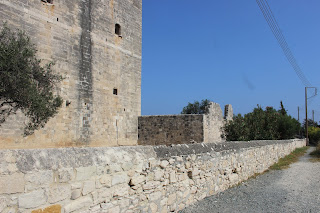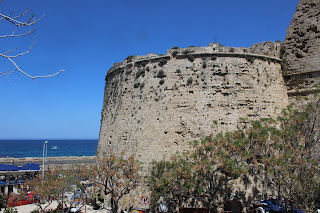

Kolossi Castle is a former Crusader stronghold on the south-west edge of Kolossi village 14 kilometres (9 mi) west of the city of Limassol on the island of Cyprus. It held great strategic importance in the Middle Ages, and contained large facilities for the production of sugar from the local sugarcane, one of Cyprus's main exports in the period. The original castle was possibly built in 1210 by the Frankish military, when the land of Kolossi was given by King Hugh I to the Knights of the Order of St John of Jerusalem (Hospitallers).
The present castle was built in 1454 by the Hospitallers under the Commander of Kolossi, Louis de Magnac, whose arms can be seen carved into the castle's walls.
Owing to rivalry among the factions in the Crusader Kingdom of Cyprus, the castle was taken by the Knights Templar in 1306, but returned to the Hospitallers in 1313 following the abolition of the Templars.

The castle today consists of a single three-storey keep with an attached rectangular enclosure or bailey about 30 by 40 metres (98 by 131 ft).

As well as its sugar. the area is also known for its sweet wine, Commandaria. At the wedding banquet after King Richard the Lionheart's marriage to Berengaria of Navarre at nearby Limassol, he allegedly declared it to be the "wine of kings and the king of wines." It has been produced in the region for millennia, and is thought to be the oldest continually-produced and named wine in the world, known for centuries as "Commandaria" after the Templars' Grand Commandery there

Kolossi Castle appears in many works of fiction, including La milicia de Dios by the Spanish writer Eduardo García-Ontiveros Cerdeño. It also appears in Snow Wasted by the Cypriot author Matthew Malekos and in the novels of several British writers, including Race of Scorpions: The House of Noccolo by Dorothy Dunnett, In Search of Sixpence by Michael Paraskos and Lionheart by Stewart Binns.
From Wikipedia, the free encyclopedia
Το κάστρο του Κολοσσιού, γνωστό και σαν Κούλας, είναι ένα από τα σημαντικότερα οχυρωματικά έργα που σώζονται στη Κύπρο, από την περίοδο της Φραγκοκρατίας

Στον πυρήνα της πλουσιώτερης κοιλάδας της Νότιας Κύπρου, στα δυτικά περίχωρα της πόλης της Λεμεσού, προβάλλει ένα από τα σημαντικότερα οχυρά της Μεσαιωνικής Κύπρου , το περίφημο Κάστρο του Κολοσσιού. Η εύφορη αυτή κοιλάδα στις εκβολές του ποταμού Κούρη αυτή αναφέρεται συχνά από τους περιηγητές του μεσαίωνα για τις απέραντες φυτείες ζαχαροκαλάμου, αμπελιών, ελαιώνων, χαρουπιών, δημητριακών και βαμβακιού και απετέλεσε κατά την Φραγκοκρατία ένα από τα σημαντικότερα φέουδα των Φράγκων ευγενών.

Το πλούσιο αυτό φέουδο παραχωρήθηκε το 1210 στο μοναχικό τάγμα του Αγίου Ιωάννη της Ιερουσαλήμ από τον ηγεμόνα της δυναστείας των Λουιζινιανών Ούγο Ι. Το όνομα της περιοχής προέρχεται πιθανότατα από τον προηγούμενο φεουδάρχη της περιοχής Gerinus de Colos.
Είναι ακόμα ασαφές πότε ακριβώς οικοδομήθηκε στο φέουδο το πρώτο οχυρό τα ερείπια του οποίου σώζονται γύρω από το νεώτερο μνημείο στα ανατολικά και τα δυτικά. Το μόνο που μπορεί να λεχθεί με ασφάλεια είναι πως αυτό οικοδομείται τον 13ο αιώνα.

Μετά την πτώση της ΄Ακρας (1291) γύρω στο 1301/2 οι Ιωαννίτες μεταφέρουν οριστικά το κέντρο των δραστηριοτήτων τους στο Κολόσσι.

Σύμφωνα με τις πηγές το1306 το Κολόσσι περιέρχεται στην κατοχή του μοναχικού τάγματος των Ναϊτών το οποίο είχε καταστεί τότε ισχυρή πολιτική δύναμη. Επανέρχεται στους Ιωαννίτες στο 1308 μετά την έκδοση των διατάξεων που εξέδωσε ο Πάπας Κλήμης με τις οποίες το τάγμα των Ναϊτών τέθηκε εκτός νόμου.

Το 1310 το διοικητικό κέντρο των Ιωαννιτών μεταφέρθηκε στη Ρόδο παρέμεινε όμως το ήδη ανεγερθέν οχυρό τους στο Κολόσσι ηέδρα ισχυρής στρατιωτικής διοίκησης γνωστή ως Commanderie. Το καθεστώς αυτό επιβεβαιώνεται με σχετική απόφαση του τάγματος το 1380. Το οχυρό χρησιμοποιείται περισσότερο σαν κατοικία και διοικητικό κέντρο των επικεφαλής του μοναχικού τάγματος οι οποίοι οργανώνουν, ελέγχουν και εκμεταλλεύονται την παραγωγή των μεγάλων φυτειών στην ίδια την κοιλάδα του Κολοσσιού και στην ευρύτερη περιοχή που κάλυπτε αρχικά όπως υπολογίζεται γύρω στα 60 χωριά.
H Commanderie του Κολοσσιού έδωσε το όνομα της στο πατροπαράδοτο γλυκό κρασί της Κύπρου γνωστό μέχρι σήμερα με το όνομα Κουμμανταρία. Προφανώς το τάγμα προώθησε την μαζική παραγωγή και εμπορία του κρασιού αυτού με το όνομα του.

Καταστροφικές επιθέσεις από τους Γενουάτες το 1373 και τους Μαμελούκους το 1402,1413,1425 και 1426 φαίνεται ότι μετατρέπουν το αρχικό φρούριο σε ερείπια.
Το 1454 ο μεγάλος διοικητής τους τάγματος Louis de Magnac B (οικόσημο σε φωτογραφία της δυναστείας των Magnac από το μεγάλο οικόσημο του Κολοσσιού στο οποίο απεικονίζονται τα σύμβολα του Βασιλείου fτων Λουϊζινιανών, της Ιερουσαλήμ, της Κύπρου και της Αρμενίας Γ σε φωτοτυπία) κτίζει ένα νέο και ισχυρότερο οχυρό το σημερινό Κάστρο.
Πρόκειται για λιθόκτιστο οχυρό με τοίχους πάχους 1.25 μ. με τρεις ορόφους συνολικού ύψους 21 μ. Το ισόγειο χρησιμοποιείται πιθανότατα σαν αποθήκη με δύο υπόγειες στέρνες. Η είσοδος στον πρώτο όροφο γίνεται μέσω μίας κρεμαστής γέφυρας. Στον νότιο τοίχο της μίας από τις δύο μεγάλες αίθουσες του ισογείου σώζεται μία τοιχογραφία με την Σταύρωση του Χριστού και το οικόσημο των Magnac foto 4που υποδεικνύει την λατρευτική χρήση του χώρου αυτού ενώ η διπλανή αίθουσα με την εστία αποτελούσε ίσως τον βασικό χώρο γευμάτων και φιλοξενίας.
Στον δεύτερο όροφο υπήρχαν άλλοι δύο χώροι οι οποίοι χρησιμοποιούνταν ως καταλύματα. Στην οροφή του μνημείου μία ζεματίστρα και πολεμίστρες μεταφέρουν στον επισκέπτη εικόνες μεσαιωνικής πολιορκίας.
Το 1488 ο Γεώργιος Κορνάρο αδελφός της τελευταίας Βασίλισσας των Φράγκων Αικατερίνης αφού έπεισε την αδελφή του να παραιτηθεί των κυριαρχικών της δικαιωμάτων στη νήσο έναντι των Βενετών, λαμβάνει ως ανταμοιβή 14 από τα 41 χωριά που ήλεγχε ακόμα η Commanderie της Ρόδου και ο εκάστοτε επικεφαλής της οικογένειας των Κορνάρων λαμβάνει τον τίτλο του ανωτάτου διοικητή της Κύπρου.
Ο τίτλος αυτός παραμένει στην οικογένεια τιμητικά και μετά την κατάληψη της Κύπρου από τους Οθωμανούς και εκχωρείται το 1799 στην οικογένεια των Μοτσενίγγο που νυμφεύθηκε την κληρονόμο του οίκου των Κορνάρων.
Στην ανατολική πλευρά του μνημείου μία μεγάλη καμαροσκέπαστη αίθουσα στεγάζει τμήμα των εγκαταστάσεων για την επεξεργασία της ζάχαρης. Το Τμήμα Αρχαιοτήτων πραγματοποιεί τα τελευταία πέντε χρόνια συστηματική ανασκαφική έρευνα στο μνημείο αυτό.
Πηγή
http://www.limassolmunicipal.com.cy/kolossi_gr.html
Photos 3/8/2016 by George Konstantinou
 Το κάστρο της Πάφου βρίσκεται στο λιμάνι της πόλης. Αρχικά χτίστηκε από τους βυζαντινούς σαν οχυρό για την προστασία του λιμανιού.
Το κάστρο της Πάφου βρίσκεται στο λιμάνι της πόλης. Αρχικά χτίστηκε από τους βυζαντινούς σαν οχυρό για την προστασία του λιμανιού. Το 1222 καταστράφηκε μετά από μεγάλο σεισμό για να ξαναχτιστεί από τους Λουζινιανούς ηγεμόνες του νησιού τον 13ο αιώνα. Το 1570 γκρεμίστηκε από τους Ενετούς. Οι Οθωμανοί το ξανά έχτισαν και το ενίσχυσαν με νέες οχυρώσεις. Ανά τους αιώνες έχει γνωρίσει πολλές χρήσεις, αρχικά ως φρούριο, φυλακή ακόμα και αποθήκη αλατιού έγινε στα νεότερα χρόνια από τους Βρετανούς. Σήμερα το κάστρο χρησιμοποιείται για πολιτιστικές εκδηλώσεις που πραγματοποιούνται κάθε χρόνο τον Σεπτέμβριο.
Το 1222 καταστράφηκε μετά από μεγάλο σεισμό για να ξαναχτιστεί από τους Λουζινιανούς ηγεμόνες του νησιού τον 13ο αιώνα. Το 1570 γκρεμίστηκε από τους Ενετούς. Οι Οθωμανοί το ξανά έχτισαν και το ενίσχυσαν με νέες οχυρώσεις. Ανά τους αιώνες έχει γνωρίσει πολλές χρήσεις, αρχικά ως φρούριο, φυλακή ακόμα και αποθήκη αλατιού έγινε στα νεότερα χρόνια από τους Βρετανούς. Σήμερα το κάστρο χρησιμοποιείται για πολιτιστικές εκδηλώσεις που πραγματοποιούνται κάθε χρόνο τον Σεπτέμβριο. Έχει ανακηρυχθεί διατηρητέο κτίριο από το 1935 και αποτελεί το σύμβολο της πόλης της Πάφου. Στο κάστρο κατά καιρούς γίνονται αρχαιολογικές ανασκαφές
Έχει ανακηρυχθεί διατηρητέο κτίριο από το 1935 και αποτελεί το σύμβολο της πόλης της Πάφου. Στο κάστρο κατά καιρούς γίνονται αρχαιολογικές ανασκαφές



























































































































































